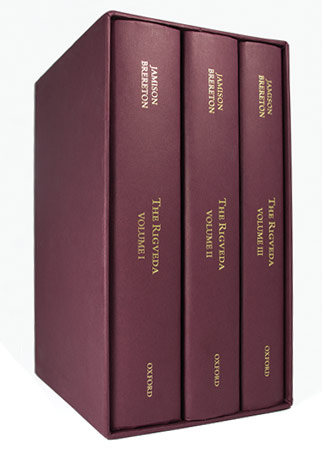Fifteen-year Project Introduces India’s Earliest Text to Modern Readers
Like so many big ideas, it all started over drinks — in this case, glasses of wine in New Orleans. Fifteen years later, a labor of love finally came to fruition for Joel Brereton, associate professor of Asian Studies and Religious Studies, when his joint translation of India’s earliest text, the Rigveda, was finally complete.
Brereton was teaching at the University of Missouri in 1998 when UT Austin Professor Patrick Olivelle invited him and his colleague Stephanie Jamison for drinks during the annual meeting of the American Oriental Society in New Orleans. Olivelle proposed a challenge for them: Do a “quick and dirty” updated English translation of the Rigveda, the oldest extant text of India that forms part of the Veda, the formal scripture of Hinduism.
“There is a good but old German translation of the Rigveda. There is a good, mostly complete French translation, and a new German translation is now underway,” Brereton says. “But the English translation that people have been using is from the 19th century, and it was already outdated when it was published. Moreover, that translation was written in a Victorian English, which would understandably discourage anybody interested in the text.”

That just would not do for such an important text, and Brereton and Jamison agreed that the only way for people to have access to the text was to do the translation. So they enthusiastically agreed to take on Olivelle’s “quick and dirty” challenge.
But “quick and dirty” it was not. Brereton and Jamison soon realized that the process would take longer than they’d initially realized. The Rigveda is composed of 1,028 hymns praising various gods that were designed to be recited during a ritual performance. The poems are believed to have been composed between 1500 and 1000 B.C. and were passed down orally over many generations and millennia.
“We got off to a somewhat slow start partly because we had other projects, but we also soon discovered that the text is more difficult than we had expected,” Brereton says. “And while we’d both done studies of the Rigveda, we found that to be responsible for every jot and tittle in the text and to render it in a way that makes it accessible required slow and meticulous work.”
Brereton and Jamison met in graduate school at Yale University, and they both studied ancient Sanskrit texts under the same professor. Brereton comes to the text from a religious studies perspective, and Jamison approaches it from a linguistics perspective.
“We knew it was going to be a long haul, but I must say that, for both of us, this is the most exciting thing we’ve ever done and probably the most exciting thing we ever will do.”
Joel Brereton
“That turned out to be hugely advantageous to us,” Brereton says. “The Rigveda is a text that can give rise to many forms of interpretation and translation. But at least we had a common, general perspective on the text. It’s not that we agreed on everything — it’s not that we still do agree — but we found ways of reaching accommodation with one another about how we were going to handle certain issues and problems in the text.”
Even though the translation is 1,700 pages long, there is not a single footnote in it. Brereton and Jamison made the decision to avoid using footnotes because they wanted the reader’s attention to be on the hymn itself. They wanted readers to be able to take in each hymn as a whole and not to get caught up in footnotes about archaic references and explanations.
They chose to write an introduction for each poem, explaining their interpretation, noting whether there were special problems and discussing things that they as translators found interesting. If Brereton and Jamison disagreed about some aspect of the translation, they were both able to share their notes and thoughts.
“The hymns are far more complex than I had realized when I began the project,” Brereton says. “The poets are very clever and artful, and their use of language and play with language are much more studied than I had imagined.”
During the 15-year-long process, both Brereton and Jamison changed jobs, Brereton to The University of Texas at Austin and Jamison to the University of California, Los Angeles. They carved out time to work on the project in between their teaching responsibilities, other research projects and various other “distractions,” such as Brereton’s stint as a department chair at UT Austin. But they both remained enthusiastic about the project and kept up the momentum over a sustained period.
Now that the translation is published, Brereton and Jamison are working to publish an online commentary about the text and to use that digital forum to share annotations from their research. The digital format also allows them to update their translation and notes as scholarship on the Rigveda advances, creating a more dynamic text.
“We knew it was going to be a long haul, but I must say that, for both of us, this is the most exciting thing we’ve ever done and probably the most exciting thing we ever will do,” Brereton says. “It was incredibly engaging. So, OK, it took a long time, but it meant that I had a good time for a long time.”

